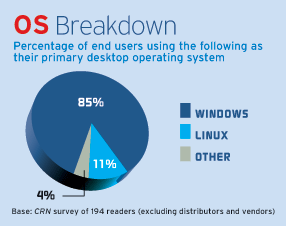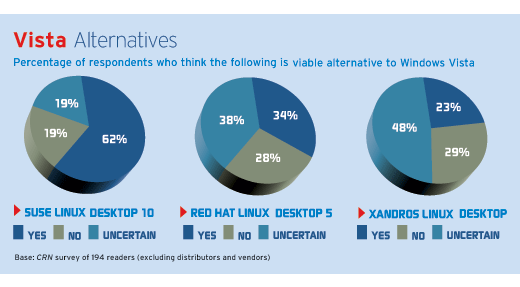VARs: Linux A Money Maker
Institute for Partner Education and Development (IPED)
Linux accounts for roughly 7 percent of total revenue for all survey respondents, and more than 20 percent of revenue for about one-third of the solution providers that boast a stronger Linux presence. Of the latter group, roughly 50 percent believe that Linux is more profitable than their other businesses, while 14 percent believe the open-source platform is less profitable, according to the study.

The results are no surprise to David Gynn, an application infrastructure expert at Optaros, an open-source consulting firm in Cambridge, Mass.
"The use of open source is a key factor in our profitability," he said. "I think we will continue to see Linux as the preferred environment to deploy open-source-based applications."
The IPED study showed a strong correlation between Linux business as a percentage of total partner revenue and partner profitability.
"There is a perfect correlation between the percentage of Linux-based solutions sold and the relative profitability of those solutions," said Rick Vieth, senior practice manager at IPED, a division of CMP Technology, the Manhasset, N.Y.-based publisher of CRN. "The more experience they have with Linux and the greater percentage of Linux in their business, the more profitable they are."
The pool of survey respondents included a wide variety of solution providers that generated more than $1 million in sales annually, and that represented some or all of their solutions are Linux-based. More than half of the respondents were C-level or senior-level directors.
Separate research from IDC echoes the IPED findings. According to one of the research firm's recent surveys on open-source adoption in the channel, one-third of all VARs, systems integrators, and consultants are generating at least some revenue from Linux.
Roughly 10 percent of all partners have made a significant commitment to Linux and are generating at least 25 percent of their revenue from Linux-based solutions, said Matthew Lawton, an analyst at IDC.
ISVs are storming in to capitalize on the expanding interest in open-source and Linux solutions in the midmarket. At LinuxWorld Expo this week in San Francisco, several ISVs including Centeris, GroundWork Open Source, Levanta, SpikeSource and XenSource are formally launching new channel programs or extending existing efforts.
XenSource, developer of the Xen virtualization engine, recently launched a Web site for a multitiered channel program the company is finalizing as it prepares to ship its first virtualization product, called XenEnterprise.
One key executive said the company's XenEnterprise product was developed with the channel in mind because XenSource has decided not to provide direct support to customers, an anomaly in a market in which open-source vendors often make their money primarily from services and support. Instead, XenSource said it will rely on the channel 100 percent for sales and service. "To build a channel-oriented product, we needed to concentrate on Windows and make it really easy for someone to carry, install, configure and manage," said John Glen, vice president of worldwide sales for the U.K.-based company with U.S. headquarters in Palo Alto, Calif.
XenSource is recruiting traditional VARs and managed service providers it has dubbed XSPs to deploy the product on Windows and Linux. XenSource supports Windows and Linux, although Glen acknowledges that the inclusion of Xen in new Linux distributions from Novell and Red Hat makes virtualization a hot profit area for Linux-oriented solution providers.

"Our chosen route to market is through a channel. Only a small quantity of VARs and systems integrators [currently] carry virtualization, but it's becoming mainstream," Glen said. "We are looking for channel partners to be involved in the delivery of services and support across the user base, and we won't dilute this by having our own professional services organization."
Many Linux solution providers deploy open-source applications on Linux and Windows, but the profit picture is better on Linux, some vendors say. SpikeSource launched a channel program earlier this year, as well as a new focus on the channel and the small-and midsize-enterprise market. The company has about 50 solution providers, including AgileCo, Dextrus and Initsoft Solutions.
Partners can earn 15 percent to 20 percent commission on the sale of a SpikeSource subscription, but they can make more money on extensions and customization work on top of the ISV's pre-integrated open-source software stacks, said Kim Polese, founder of SpikeSource. These high-end services tend to be more profitable than typical integration services, she said.
Polese and other SpikeSource executives say profitability is better for partners that deploy on Linux, as opposed to Windows.
"The use of open source and Linux frees up the budget that goes into product licenses for proprietary software," said Corey Williams, director of product management at the Redwood City, Calif.-based company.
According to the IPED study, solution providers cited cost savings as the top reason for deploying Linux. And although Linux got its start in the enterprise market, its increasing penetration into SMBs makes it a ripe opportunity for partners.
Revolution Linux is a Sherbrooke, Quebec-based company that deploys open-source applications on Windows and Linux but prefers to deploy on Linux.
"What's interesting with Linux is scalability. If you use one server or 100 servers, it's the same cost for licenses," said Patrice Albaret, a business developer at Revolution Linux. "We see it as a big profit opportunity." The company's revenue has doubled each year.
Albaret noted that Revolution Linux will make more profit on a typical Linux implementation, but during the first year on a major project, it tends to be profit-neutral because of the higher costs of customization and training his team. Still, the delivery of a more secure, more customized and feature-rich Linux solution translates into higher profitability in the long run, he said.
Some Linux partners also are seeing increased profitability as customers deploy higher-end applications on Linux. According to the IPED study, one-third of the revenue from the strongest Linux solution providersthose earning more than 20 percent of their revenue from Linuxcome from deploying Linux for mission-critical applications, not edge appliances.
San Francisco-based GroundWork has signed up six partners, including Novacoast and Revolution Linux. As part of GroundWork's partner program, VARs get a flat 25 percent fee on product sales and 100 percent of the services business they generate from the open-source platform.
Initially, partners will be shadowed by GroundWork Professional Services to teach partners the ropes. There is a program fee of $15,000, but the fee is waived in lieu of partners paying GroundWork Professional Services consultants for their time on those first few service co-engagements, said Tony Barbagallo, vice president of product management at GroundWork.
"The only way to scale is though the channel," said Barbagallo, who built an indirect channel for Dantz, which is now owned by EMC. He said GroundWork initially ran 90 percent on services and 10 percent subscriptions, but the product- services ratio has shifted to an even 50:50.
Vendors' business models are firming up, and this is enabling some of the Linux channel growth, observers say. "If you want to get any traction with the channel, you have to prove the market, and that's what we've done," Barbagallo said. "We have a small direct sales force and professional services arm that has proven the marketing and business model, and we can show the business case with empirical data."
Centeris, Bellevue, Wash., is the ISV behind the recently released LikeWise 2.0 server management suite, which enables Linux to better interoperate with Windows networks.
Centeris executives are finalizing a formal partner program, to be announced later this fall, that it hopes will spawn and support a crop of service providers and resellers to serve the midmarket, said Centeris Vice President of Sales Lee Finck, who formerly ran F5 Network's channel.
"We'll deliver a more formal program later this fall for selling and providing services to midmarket companies," Finck said.
One Centeris executive said it makes sense that more channel programs are being launched as Linux spreads downmarket.
"If you look at Red Hat's results recently, they cited an increase in midmarket customers," said Manny Vellon, co-founder of Centeris. "They've got 25,000 new subscribers, and by definition, they can't all be Fortune 2000 companies."
Linux management vendor Levanta also plans to kick off a multitiered U.S. channel program at LinuxWorld Expo. The ISV will offer a premier-plus level and a second preferred level that is based on referrals.
Paul Anderson, president of Novacoast, Santa Barbara, Calif., said Linux accounts for roughly 5 percent to 10 percent of his company's sales and is growing.
"I don't see that it's any more profitable than our other service offerings, but it is certainly a high growth revenue opportunity for us," he said.